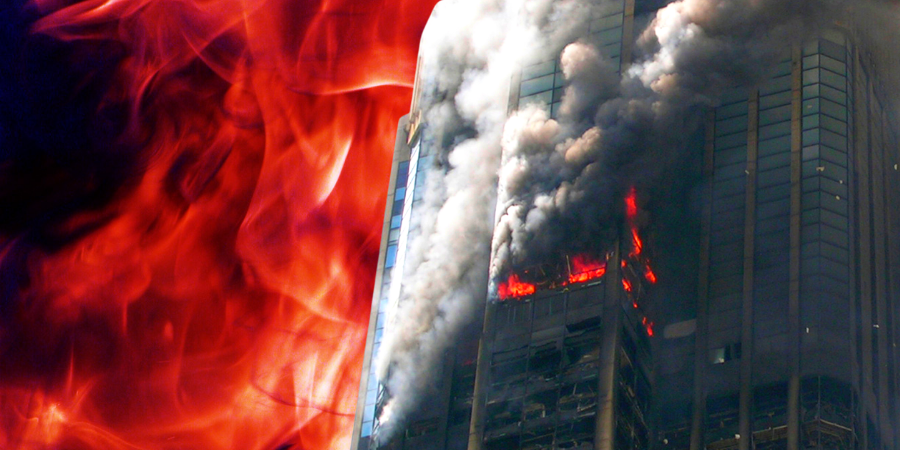What is a fire alarm system and why is it important?
Fires spread FAST! According to the UL Firefighter Safety Research Institute, a building fire can become deadly in just 3 minutes. With so little time to escape to safety, rapid detection and notification are crucial. That's where fire alarm systems come in.
A fire alarm system is a network of electrical components that detects and notifies people of a fire or other emergency event. Because their primary function is to protect life, fire alarm systems can also be referred to as life safety systems.
Fire alarm systems can be complex, especially when integrated with other systems in a building. Furthermore, they must adhere to building codes, electrical codes, fire alarm codes, and other standards and regulations. It can be difficult for business owners and facility managers to tackle such an important aspect of their building's safety. So, we'll dive into an overview of fire alarm systems to familiarize you with common terminology and help you get a better understanding.
Who needs a fire alarm system?
National and state laws require most commercial properties to have a fire alarm system for life safety purposes. These include retail, factories, offices, schools, hospitals, apartment buildings, and more. Currently, Ohio does not require fire alarm systems for single residences.
The National Fire Protection Association (NFPA) outlines the minimum requirements for commercial fire alarm systems in NFPA 72: National Fire Alarm and Signaling Code. The NFPA determines specifications based on property/occupancy type. For instance, a chemical factory will have significantly different life safety requirements than a high-rise apartment complex.
Additionally, there may be fire alarm regulations set forth by your local authority having jurisdiction (AHJ). For example, rural areas on the outskirts of Lima may have different regulations than those in the densely populated area of downtown Columbus.
The Buying Process for Fire Alarm Systems
There are many reasons why you may be searching for a fire alarm system for your business. New construction or property conversion/takeover may require a fire alarm system. You may need to add to your existing system due to an addition or renovation. Maybe you need to update your existing outdated or discontinued system. Or possibly, you're just trying to meet your AHJ's requirements after an inspection.
Whatever the reason, the codes and regulations governing commercial fire alarm systems can make the buying process daunting. That's why we've compiled this guide to walk you through every step of the way.
Getting Quotes for Fire Alarm Systems
First, you'll want to contact local installers to get quotes for your fire alarm system. Unless your property is new construction, the installer should schedule an on-site consultation to inspect the existing system and property. They may also request a copy of your building's floor plans. These will enable the installer to provide an accurate quote for your business's life safety needs.
As with all quotes, you should know what the price includes and excludes. Ask questions to get a clear picture of the products and services quoted.
Questions You Should Ask
Q: Will my system be designed according to code?
Make sure a certified fire alarm designer or licensed engineer will be designing the system to the minimum requirements specified in NFPA 72.
Q: What reporting methods will the system use?
Discuss which reporting method would work best for your facility with your system designer. For example, you may opt for cellular communication over traditional phone lines to avoid additional fees and maintenance.
Q: Can you reuse any of the existing fire alarm wiring or equipment?
If you are renovating your building or just need to update/upgrade your existing fire alarm system, you may be able to reuse some of the wiring and/or equipment already in place. Your designer can inspect what you have and make recommendations to potentially save you money.
Q: Will fire watches be required during installation?
When the fire alarm system is offline due to repair, replacement, or additions, fire watches may be required. NFPA Life Safety 101-3.3.108 defines a fire watch as “The assignment of a person or persons to an area for the express purpose of notifying the fire department, the building occupants, or both of an emergency; preventing a fire from occurring; extinguishing small fires, or protecting the public from fire or life safety dangers.”
Q: Are any devices to help reduce false/nuisance alarms included?
There are devices available to help reduce false alarms or nuisance alarms, such as EDWARDS Signature Optica Detectors. These types of devices can save you both time and money. Check with your designer to see if they offer them and if they are right for your facility.
Q: What is the proposed overall timeline of this project?
Discuss the timeline of your project with the installer. Be prepared – the timeline for most fire alarm projects is in weeks, not days.
Q: Is hands-on training included?
Check with your installer to see if they provide hands-on training on the new fire alarm system with you and your staff.
Q: Do you offer services to maintain the fire alarm system after installation?
Full-service systems integrators, like NWOSS, offer services to maintain the fire alarm system after installation, such as testing and inspections.
Need a fire alarm system?
Contact one of our Fire Alarm experts for a free quote.

Choosing a Fire Alarm System Contractor
Choosing the right team to install your fire alarm system goes beyond price. You want to make sure the fire alarm contractor you select is the best all-around fit for your project - cost, products, and services. Here are our top tips for what to consider when you're making your selection.
At a minimum, a Fire Alarm Contractor should have:
- License & insurance for business purposes.
- License(s) specifically for fire alarm work.
- Certified Engineers to design the system.
- Project Managers to oversee scheduling & permits.
- Experienced Installers.
In addition, you may want to consider the following questions:
- Do you want to work with a local contractor?
- Does your business need 24-7-365 service?
- Do you want a contractor that can take care of all your business's fire alarm needs (design, install, monitor, service, etc.)?
- Would you prefer an integrator that can oversee all your low-voltage systems (fire alarm, security, access control, intercom, video surveillance)?
Fire Alarm Permit Process
New fire alarm systems and most changes to an existing fire alarm system will require a permit. A permit ensures that the system meets all applicable codes and regulations. Some aspects of the permit review process, such as cost and length, vary depending on the AHJ. Therefore, it's imperative to choose an experienced fire alarm contractor who can easily navigate this process for you.
Here, we give a brief overview of what's entailed in the fire alarm permit process. Please know that the length of time needed to complete this process varies. It depends on the project's scope of work and the availability of the AHJ. Sometimes, projects can begin installation in under four (4) weeks. Occasionally, it can take upwards of eight (8) weeks or more just to obtain a permit. Be prepared and plan accordingly.
System Design
As we've mentioned many times throughout this article, fire alarm systems must adhere to codes and regulations. Therefore, by law, a certified fire alarm designer/engineer must design the system.
The engineer designs the system by applying fire alarm codes to your facility's floor plans.* Then, they factor in system functionality and features particularly suited to your business. Finally, the engineer determines the appropriate wiring and power supplies needed for the system using mathematical calculations.
*NOTE: If you do not have a copy of your facility's floor plan(s), the NWOSS CAD team may be able to create them for you.
Permit Drawings
Here at NWOSS, we have a dedicated CAD (computer-aided design) team that finalizes the system design in an electronic format. The completed drawings show the locations of each device in your facility. Additionally, they will include a wiring diagram detailing how the system will be connected.
Furthermore, the CAD team assembles a Submittal Packet. This packet includes data sheets for the equipment, all necessary calculations such as battery requirements & voltage drops, and copies of licenses/certifications.
Permit Application
Finally, your fire alarm contractor prepares a permit application for the appropriate AHJ. Then, they submit the application, drawings, and submittal packet to the AHJ for review, along with any required fees. Permit application costs vary depending on the fee schedule set forth by the AHJ.
The AHJ reviews the plans to make sure they meet all applicable codes and regulations. The length of this review period varies depending on the AHJ and the number of other applications submitted. In Ohio, these reviews usually take 2-6 weeks to complete.
Installing a Fire Alarm System at Your Business
Once the AHJ issues the permit for your project, your fire alarm contractor will schedule installation to begin. They will tailor installation procedures and timeline to the project’s scope of work and the facility’s use type. An experienced installer will anticipate the requirements for your project to ensure a smooth, efficient installation process. The process typically involves removing any existing equipment, mounting and wiring new equipment, programming, and testing.
Inspection
When the contractor has successfully installed and tested your new fire alarm system, they will schedule an on-site inspection by the AHJ. The inspector will make sure the system was installed according to the approved plans. They will also thoroughly test the system. Once satisfied that the system meets code and is fully functional, the AHJ will give final approval of the system.
Training
The installer should train you and your staff on how to operate your new system. They should provide you with a user manual, go over basic functions, and explain the various alerts. Moreover, they can answer any questions you have about the system.
Discover how we can help with your next fire alarm project.
We have a team of experts to help every step of the way.

Types of Fire Alarm Systems
There are two main types of fire alarm systems - manual and automatic.
Manual Fire Alarm Systems
A manual fire alarm system must be manually activated by a person using a pull station. Only certain property types are eligible for a manual system.
Automatic Fire Alarm Systems
An automatic fire alarm system includes pull stations for manual activation PLUS sensors/detectors to automatically initiate an alarm.
Components of a Fire Alarm System
A fire alarm system consists of four main components: initiating devices, notification appliances, control panels, and communications.
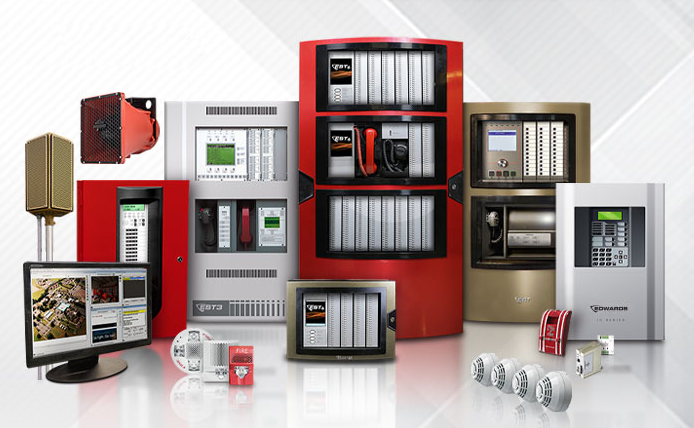
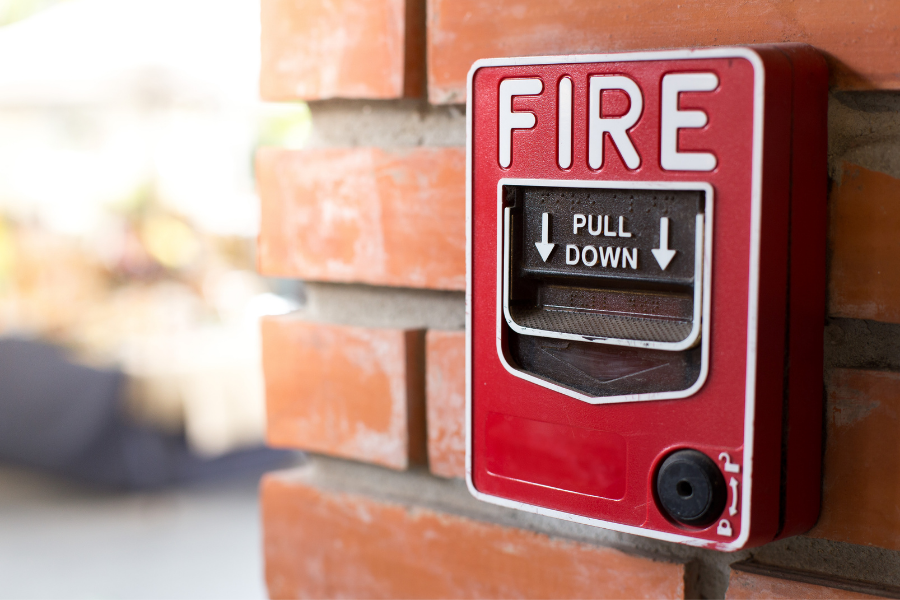
Examples of initiating devices:
Life Safety Sensors: Smoke Detectors, Heat Detectors, Duct Detectors, Beam Detectors, Carbon Monoxide Detectors, 4D Multi-sensors & more
Video-Based Fire Detection: Thermal Imaging Cameras, Smoke & Flame Video Analytics
Pull Stations: Single-Action, Double-Action, Glass-Break, Weatherproof, Explosionproof, Pull Stations with Tamper Covers & more
Notification Appliances
Notification appliances alert building occupants of a potentially life-threatening event. When an alarm is triggered, the panel activates the notification appliances. These devices can produce signals audibly, visually, or both.
To ensure an alarm can be heard and seen throughout a facility, NFPA 72 specifies minimum coverage and maximum spacing of notification appliances.
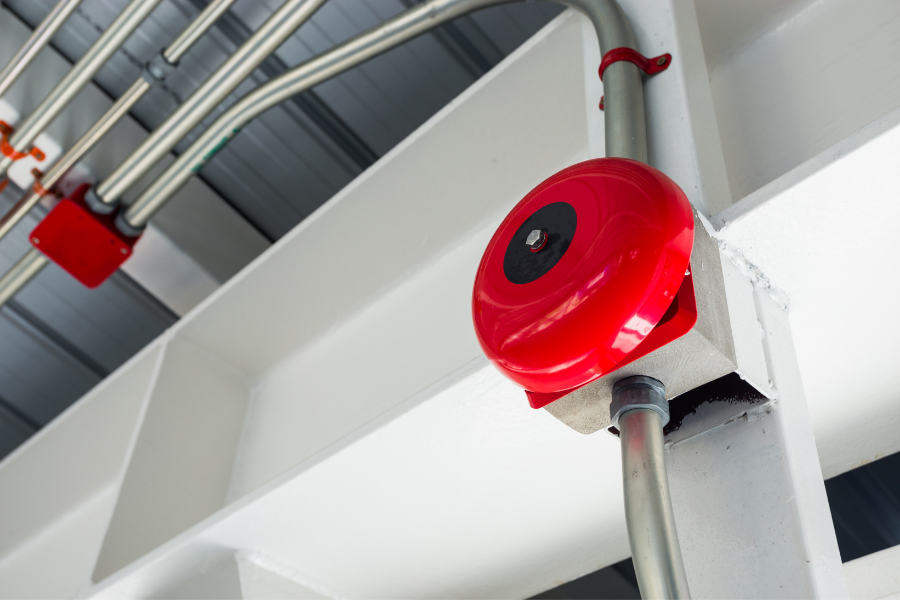
Examples of notification appliances:
Audible Notification: Horns, Speakers, Bells, Sirens & more
Visual Notification: Strobes
Dual Notification: Horn-Strobes, Speaker-Strobes
Fire Alarm Control Panels (FACP)
A fire alarm control panel (FACP) is the command center for the entire fire alarm system. The FACP connects to all devices on the system, managing power, data, and communications.
FACP types are classified by the way they receive and report signals from initiating devices. There are two types of fire alarm control panels: conventional and addressable.
Conventional Fire Alarm Systems
Conventional fire alarm control panels receive and report alarms in zones. Each conventional panel comes with a set number of onboard zones. All the initiating devices on a zone are wired together. Therefore, they are all considered the same zone and are not labeled individually. This means that you would not be able to determine which specific device triggered an alarm, you would only know that it was one of many devices on that zone. For this reason, conventional fire alarm systems are typically not recommended for large buildings or multi-building sites.
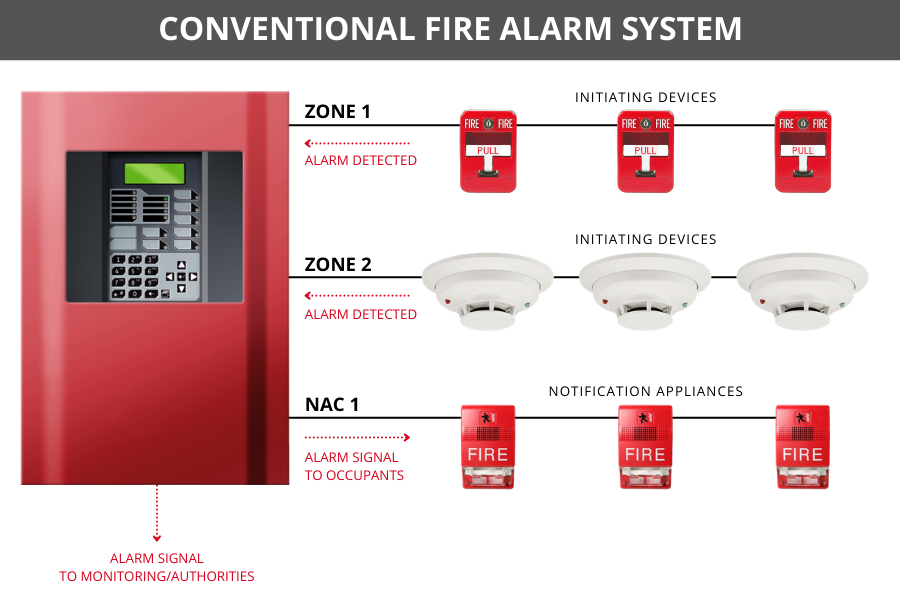
Addressable Fire Alarm Systems
Addressable fire alarm control panels receive and report alarms in addresses. Every initiating device connected to an addressable panel has its own address. So, you will always know which specific device triggered an alarm.
Because of this, addressable panels offer more flexibility than conventional ones. For example, the FireWorks® platform mentioned below is only compatible with addressable systems.
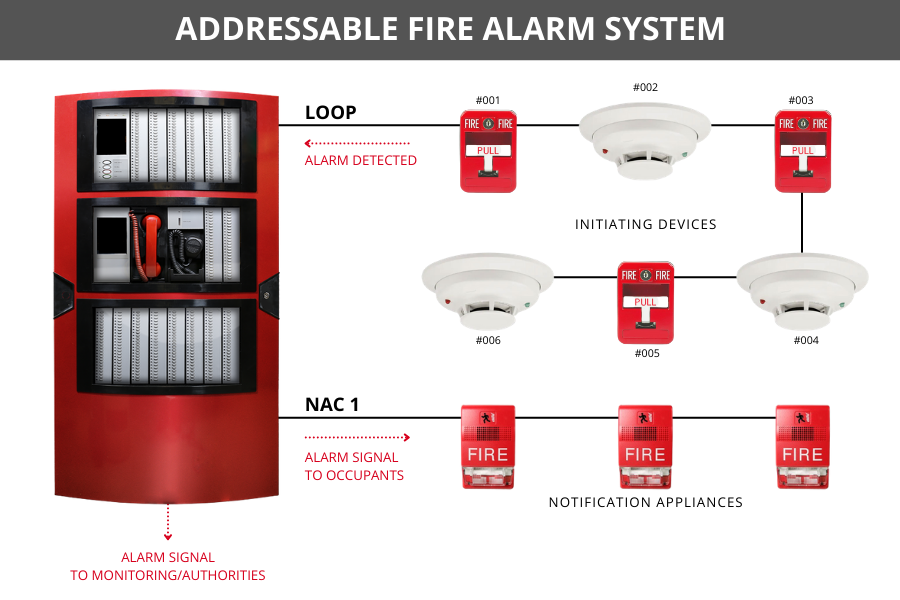
Communications
There are several ways a fire alarm system communicates alarms and other important notifications.
Remote Annunciation
An annunciator is an indicator panel that is located away from the main control panel, usually near the main entrance. It displays the status of the fire alarm system. It also displays the zone/address of the triggering alarm.
Incident Management Platform
EDWARDS FireWorks® is an incident management command and control platform. Using a computer workstation, FireWorks® presents information graphically. It offers real-time insight into different aspects of an incident using facility maps, live video feeds, audio channels, and other information. FireWorks® enables users to pinpoint the exact location and type of alarm, which can be especially helpful in large facilities or across multi-building campuses.
Monitoring
An important aspect of fire alarm systems is their ability to communicate with a monitoring center (see Types of Fire Alarm System Monitoring). In case of an emergency, the monitoring center alerts local authorities. Therefore, alarm monitoring frees occupants to focus on getting to safety.
An FACP must have some sort of onboard communicator to transmit signals to the monitoring station. There are three types of communicators - network, dialer, and cellular.
Network Alarm Communicators
Network communicators use an Ethernet connection to transmit signals across your facility's existing data network.
Dialer Alarm Communicators
A dialer uses hardwired phone lines, aka landlines, to transmit alarm signals to an off-site monitoring station. NFPA 72 requires a minimum of two (2) phones for communicating fire alarm signals when using a dialer. Beware, if your FACP uses a dialer, you will need to pay your local telephone company for phone service and maintenance of the lines.
Cellular Alarm Communicators
Based on the same technology as your cell phone, cellular alarm communicators transmit signals from the FACP to the monitoring station over a cellular network. Unlike a dialer, the cellular communicator does not require you to pay a cell phone company for service.

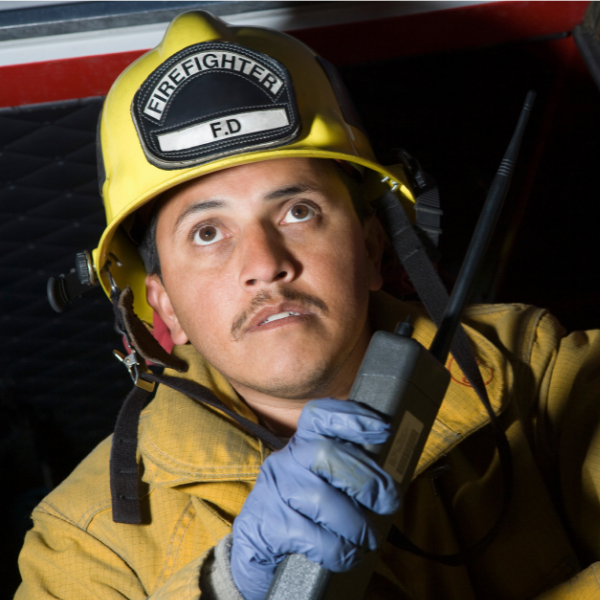
Types of Fire Alarm System Monitoring
Fire alarm system monitoring is crucial for commercial spaces. Because fires can spread quickly, rapid response is vital to save lives and assets. A monitoring or supervising station is a facility that receives signals from the FACP. They have dedicated staff to monitor signals 24-7-365 to alert emergency responders of fire right away. Fire alarm systems may be supervised on-premise or off-site, depending on what is acceptable by the AHJ for your facility.
On-Premise Monitoring
On-premise monitoring stations, also known as Proprietary Supervising Stations must staff their own stations. They are mainly used by very large buildings or campuses such as airports, factories, and universities. FACP's typically use network alarm communicators to transmit signals to a Proprietary Supervising Station.
Off-Premise Monitoring
The majority of businesses rely on off-premise monitoring. Central Stations and Remote Supervising Stations are the two types of off-site fire alarm system monitoring. FACP's typically use dialers or cellular alarm communicators to transmit signals to the Central or Remote Supervising Station.
Maintaining Your Fire Alarm System
Be prepared to maintain the components of your fire alarm system according to the manufacturer's instructions. In addition, fire alarm systems also require regular inspecting and testing according to the schedules set forth by NFPA 72 and/or your local AHJ.
Fire Alarm System Inspections
Inspect the components of your fire alarm system regularly. Look for loose connections, corrosion, damage, etc. Check that LED indicators and screens are in working order. Make sure devices are clean and free of obstruction.
Fire Alarm System Testing
Regular fire alarm system testing is essential for life safety. Confirm the FACP transmits signals properly and promptly to the monitoring station. Verify initiating devices trigger an alarm event. Demonstrate notification appliances produce audible/visual signals upon alarm. Test batteries and power supplies.
As you can see, fire alarm systems are complex! If you still have questions, please feel free to reach out to one of our experts at 800-833-6416. We are here to help you keep your customers, staff, and assets safe and secure.
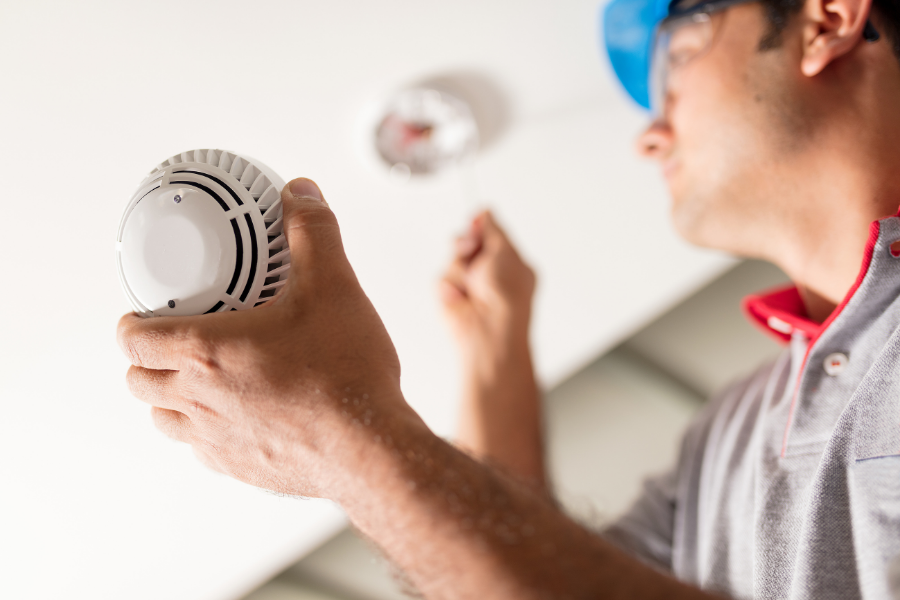
Let us help you with your fire alarm system!
Our full-service team can provide inspections, testing, maintenance, and monitoring for life safety systems.

